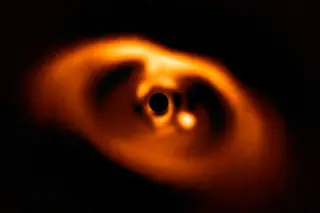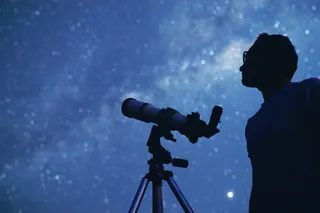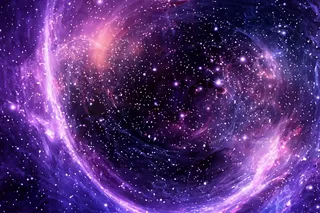When we say something is a “chip off the old block,” that generally means the new thing shares basic characteristics of the object from which it originated. In pebbles, that literally means the smaller stone’s mineral composition matches that of the larger rock from which it broke. For people, that means personality traits, DNA, resemblance to a parent.
But for young planets, that appears not to be the case. Using a relatively new, highly sensitive imaging technique, astrophysicists examining both the disc of dust and gas that coalesces to form a planet — as well as the planet itself — found a significantly different ratio of two key chemical components. A team of astrophysicists reported this unexpected finding in Astrophysical Journal Letters.
“The disc has a lot of carbon compared to oxygen and the planet doesn’t,” says Jason Wang, a Northwestern University astrophysicist and an author on the paper. “That was the basic mismatch we found.”
Learning How Planets are Formed
This mismatch has profound implications in understanding planetary formations, which Wang admits is relatively primitive. One reason is that opportunities to witness planetary births are relatively rare. Another is that, until recently, scientists had a hard time separating the chemical components that appear as light spectra from the disc, the new planet, and nearby objects, including the remnants of the star that produced the dusty disc that eventually becomes a protoplanet.
This is the first time the carbon and oxygen compositions of a birthing star, the natal disc, and a protoplanet were compared using a technique Wang and his colleagues had developed earlier to isolate the light from just the disc and the planet. They essentially filtered out the much brighter waves from the birthing star.
“It’s really difficult to separate, because the star is so much brighter,” Wang says.
Northwestern research fellow Chih-Chun (“Dino”) Hsu, who ran the data collection portion of study, was surprised at what he saw. The findings ran counter to the conventional wisdom that the ratio of carbon and oxygen gases in a planet’s atmosphere should match the ratio of carbon and oxygen gases in its natal disk.
“When Dino ran that analysis and we got the number out, I said ‘Wow,’” says Wang. He was surprised because the observation has the potential to change how astrophysicists understand planetary formation.
Read More: 6 Exoplanets in our Universe That Could Support Life Other Than Earth
Rare Birth Viewing
Witnessing the birth of a planet is relatively rare, says Wang, because they occur in a relatively short time scale — within a few million years. That’s a drop in the bucket in a system whose time scale is measured in the billions.
Not only were the scientists fortunate to catch the planetary formation short window, they were also lucky to see it happen relatively nearby — a mere 366 million years light years from Earth. That’s plenty close for the powerful telescopes at the Keck Observatory in Mauna Kea, Hawaii.
Two Possible Explanations
The scientists suspect two possible scenarios might explain the surprising result. One is that the planet might have formed before carbon entered the disc. Another explanation is that the planet grew by absorbing solids, as well as gases. Their imaging technique can only measure the composition of gases.
Wang notes that, while the planet’s composition differs from the disc that gave rise to it, it more closely matches materials from the star that produced the disc. “The disc is the remnants of star formation,” says Wang. “So the birth material of the planet is the same material as the star.”
The team will next compare a neighboring planet brought forth from the same natal disc. The one they’ve already studied is named PDS 70b. They will turn their instrumentation to its neighbor, PDS 70c.
Ideally, they will develop techniques to measure different universe building blocks — perhaps potassium, iron, or sulfur.
“We want to go beyond carbon and oxygen and study other things,” says Wang. “It would be really interesting to go after some other elements.”
Read More: This Eyeball Planet Could Be The Best Place To Look For A Habitable World
Article Sources
Our writers at Discovermagazine.com use peer-reviewed studies and high-quality sources for our articles, and our editors review for scientific accuracy and editorial standards. Review the sources used below for this article:
Astrophysical Journal Letters. PDS 70b shows stellar-like carbon-to-oxygen ratio














